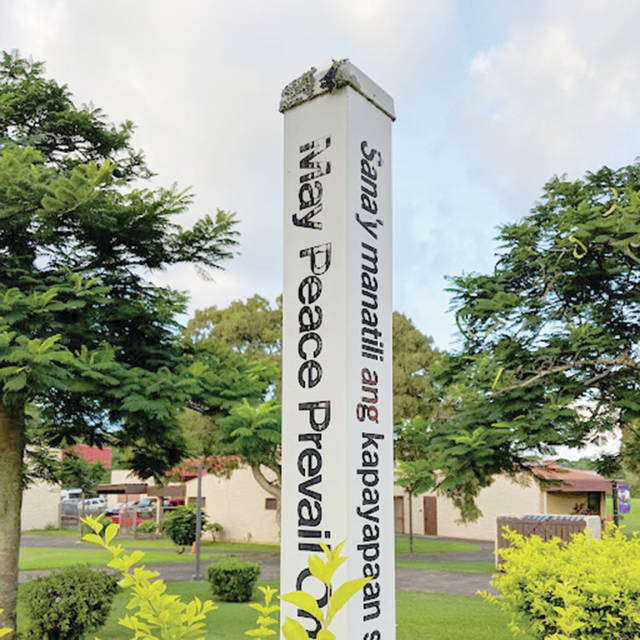Last December, a story and photos of peace poles on Kauai caught my eye and interest (thegardenisland.com, Dec. 6, 2017, “Health and Fitness”). I didn’t recognize the byline, but the subject and images captured my imagination. I reached for my trusty orange scissors and clipped the article, thinking I’d like to see the actual subjects of the photos and the peace pole examples mentioned that exist on our island, and also mail out copies. I felt moved to spread the word of these positive symbols to my grown children and their children, my grandchildren on the mainland, who might like to promote a peace trend in their communities and schools.
My husband and I had traveled to several places mentioned in the story. How was it that we hadn’t seen the peace pole at Machu Picchu, Peru; at the Great Pyramid of Giza in Egypt; and at the Atomic Bomb Dome in Hiroshima, Japan, the area from which his family emigrated? Maybe we traveled there before the peace poles were erected. We would have wanted to see these, being advocates for peace. Like so many people of our generation (not to speak of before, and after), both of us had our families and our lives completely disrupted by the events of World War II and all the wars that have followed and are still taking lives.
Discounting that, how could I have missed the first peace pole that the writer, Terri Donovan Mansfield, had seen with her husband in Hanalei, not to mention several places with which we’re familiar, such as Lydgate Park and the campus of Kauai Community College? However, I did remember that I had seen and admired the peace pole that stands in “Sparky’s Peace Garden” (“Sparky” being the nickname for the late Sen. Spark Matsunaga) during my visits to the Storybook Theatre and its Children’s Peace Garden in Hanapepe.
A peace pole, like a vertical Hawaiian ahu (altar, shrine) stone, is firmly planted in the earth, but aims toward the galaxies — the same (I realize while writing this), as we human beings who walk and stand upright. Following that thought through, each of us who makes a stand for peace during our life journey becomes a living peace pole.
Mankind has erected similar symbols of polarity since the earliest of times and incorporated them into sacred art and architecture, ancient and modern, secular and religious. Think of ancient obelisks (the iconic — and ironic — one filmed in “2001, A Space Odyssey”) and cenotaphs, pillars and lingams, poles, steeples, towers and towering monuments (such as the Washington Monument), similar smaller grave markers, and futuristic skyscrapers. These stand worldwide as physical expressions of the concept of peace.
The pioneering American journalist Dorothy Thompson pointed out in “On the Record,” that peace is not just the opposite state of war: “They have not wanted peace at all; they have been wanted to be spared war — as though the absence of war was the same as peace.” Many sources teach that peace exists as a state of inner being that must be striven for so as to have harmonious outward expression of thought translate into actions and deeds.
These thoughts came up to be re-sorted in mind during a time of recent sad personal conflict that left me jangled, far from a peaceful inner state. I was working to swim back toward inner calmness some weeks ago when, serendipitously, I met Terri Mansfield in a pleasant social situation. I learned that she was the “peace lady” who wrote and photographed the column I’d clipped, and then a great deal more about her journey that led to her work and promotion of peace.
I mentioned that I was upset with the news that, according to a presidential announcement, our country was to develop a new department of war beyond our Army, Navy, Air Force and Marines — that of a space force. That’s when I learned that Terri had been associated with Apollo 14 Astronaut Edgar Mitchell, the sixth man to walk on the moon (1971). I knew from earlier reading that Mitchell found his conceptual life so changed after his mission that he founded the Institute of Noetic Sciences, through which studies were done on the connections between science and religion as well as healing and consciousness. But I didn’t know that he later founded a company in which he and a team of scientists researched the application of the quantum hologram as well as zero point energy (ZPE) as an alternative, workable and affordable energy to replace fossil fuels and electricity.
Thunderstruck, I realized that the harnessing of ZPE would, no doubt, eliminate the truth or hidden element of our past and current middle-Eastern “forever” wars — black gold, spelled O-I-L. Meanwhile, Terri was mentioning having been in Washington, D.C., for a tour into the bowels of the Pentagon to visit an official representing the Department of Peace, I realized with a start that I knew nothing of such a national department and feel the need to learn more.
Here on Kauai the International Day of Peace has arrived with several community celebrations, a ceremony and rally which we’re about to attend (after the “Green Flash” deadlines). We need to learn more about our own Kauai peace heroes, the late Sen. Matsunaga and also the Rev. Miyoshi, who are being honored in ceremonies in Hanapepe between the Storybook Theatre and the Soto Zen Temple. We want to hear Alton Takiyama-Chun’s historical presentation of the senator’s life and philosophy.
More soon on finding and making a peace pole. Aloha, Dear Readers.
•••
Dawn Fraser Kawahara, resident author and poet, has focused her supportive interests within the Kauai community since the early 1980s. She and her husband, a retired biology teacher, live in Wailua Homesteads. Their passion for travel flows into the writer’s TGI column, “FarAway Places.” Kawahara’s books are available through Amazon and other outlets. For information, tropicbirdpress@gmail.com.


